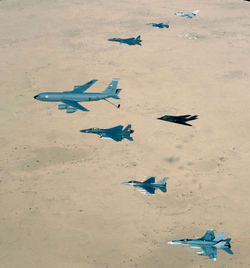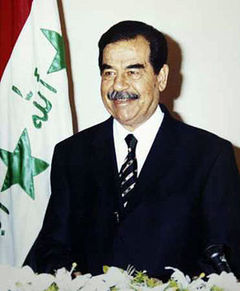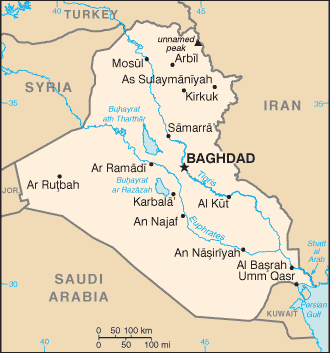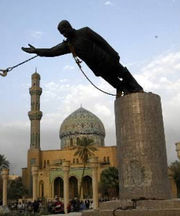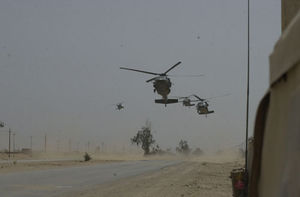|
TERRORISM - IRAQ and SADDAM HUSSEIN |
|
HOME | CASE STUDIES | LAW | NEWS | POLITICS | RIGHTS | SCANDAL | SITE INDEX | WHISTLEBLOWING |
|
The term terrorism is largely synonymous with "political violence" or the threat of violence, and refers to a strategy of using coordinated attacks that typically fall within the time, manner of conduct, and place commonly understood as unconventional warfare.
"Terrorist attacks" are usually characterized as "indiscriminate," "targeting of civilians," or executed "with disregard for human life." The term "terrorism" is often used to assert that the political violence of an enemy is immoral, wanton, and unjustified. According to the definition of terrorism typically used by states, academics, counter-terrorism experts, and non-governmental organizations, "terrorists" are actors who don't belong to any recognized armed forces, or who don't adhere to their rules, and who are therefore regarded as "rogue actors".
Because of the above pejorative connotations, those accused of being "terrorists" rarely identify themselves as such, and instead typically use terms that refer to their ideological or ethnic struggle, such as: separatist, freedom fighter, liberator, revolutionary, vigilante, militant, paramilitary, guerrilla (from Spanish "small war"), rebel, jihadi or mujaheddin (both meaning "struggler"), or fedayeen ("prepared for martyrdom").
Bomber and strike aircraft over Iraq
CAUSES
Theories on the causes of terrorism include:
The existing social orders within countries, and the global order of states, include structural compromises and agreements between various groups and interests, which often arose in resolution of past conflicts. Over time, these arrangements may become less relevant to the current situation, as unforeseen groups and interests arise. Liberal democracy itself is intended to prevent small groups redesigning society according to their norms. Democracies may succeed in this respect, but will then create a society which these groups will reject. Some theories assume that groups resort to terrorism when other avenues for change, including economic campaigns, protest, public appeal, and standard warfare, hold no hope of success. This is related to the criterion of ultima ratio (last resort), in just war theory. From this perspective, terrorist acts are calculated to disrupt the existing order and provoke conflicts, in the expectation that the outcome will be a new order, more favourable to their interests. Applied to anti-terrorism policy, this approach suggests policies that will create and sustain an alternative, peaceful, avenue of problem resolution, particularly in the case of marginalized and oppressed populations. Ideological theories, on the other hand, often imply that nothing can be 'resolved', because the conflicting ideologies are logically incompatible.
SEPARATISM
During much of the 20th century, the term terrorism was primarily applied to nationalist movements of various types. Most of them were separatist movements, seeking to create a new independent nation-state on the territory of a larger, existing state. There were also some cases of non-state irredentist violence, seeking to annex territory. Classic counter-terrorist operations were a feature of the decolonization in Africa and the Middle East. Some of these campaigns, such as the Mau Mau and the FLOSY, were well known in the Western media, but unlike Al-Qaeda, their violence was remote and confined to the disputed colony.
However, Irish republican groups did consistently target England, and the Basque ETA often targeted Madrid and other non-Basque parts of Spain, as well as the felquistes in Québec. The motives of these groups derive from their nationalist ideology, and an underlying territorial conflict about which state should control what. In this respect, no separate theory of the causes is required, since violence is the standard instrument of geopolitical change. For example, given the competing claims on the former British mandate of Palestine, the chance that the Zionist movement could ever have reached agreement on the peaceful transfer of millions of Jews to the region seems non-existent. Thus, the violence resulting from territorial conflicts is frequently considered inevitable.
DEMOCRACY
Research shows that terrorism is most common in nations with intermediate political freedom. The nations with the least terrorism are the most democratic nations.[5][6][7]
TERRORIST PROFILE
Acts of terrorism can be carried out by individuals or groups. According to some definitions, clandestine or semi-clandestine state actors may also carry out terrorist acts outside the framework of a state of war. The most common image of terrorism is that it is carried out by small and secretive cells, highly motivated to serve a particular cause. However, some acts have been committed by individuals acting alone, while others are alleged to have had the backing of established states. Over the years, many people have attempted to come up with a terrorist profile to attempt to explain these individuals' actions through their psychology and social circumstances.
Osama Bin Laden
OSAMA BIN LADEN
Usāmah bin Muhammad bin 'Awad bin Lādin (Arabic: أسامة بن محمد بن عوض بن لادن; born March 10, 1957 [1]), most commonly known as Osama bin Laden or Usama bin Laden (أسامة بن لادن) is an Islamic fundamentalist, a primary founder of the al-Qaeda organization and a member of the immensely wealthy bin Laden family.
Bin Laden and al-Qaeda have allegedly committed several attacks worldwide, including the allegation that they both were directly responsible for the September 11, 2001 attacks on New York City and Washington, D.C., which killed at least 2,985 people. In addition, they have been linked to the bombings at the U.S. Embassy in Dar es Salaam, Tanzania and U.S. Embassy Nairobi, Kenya and the USS Cole.
According to an audio tape released by Osama bin Laden, his main grievances against the West and especially the United States, include their support for the State of Israel, their support for several dictatorial regimes in the Middle East, and the presence of United States military bases in Saudi Arabia, where the Islamic holy cities of Mecca and Medina are located. The U.S. withdrew from these bases in 2003 stating that they were no longer necessary for their campaign in Iraq.
The United States Department of State is offering a reward of 25 million US dollars for information leading to the capture or death of bin Laden. An additional reward of $2 million is being offered by the Airline Pilots Association and the Air Transport Association for an unrelated issue. [2] While bin Laden's current whereabouts are unknown, the most popular assumption is that he is hiding in Pakistan's tribal region of Waziristan bordering Afghanistan, or, more specifically, near the small Pakistani market town of Chitral [3], [4]. If bin Laden is in Pakistan, it is possible that he benefits from local support by the Waziri. With the inhospitable mountainous terrain, the United States faces many difficulties in pursuing his capture, despite a wide array of sophisticated eavesdropping sensors deployed in the region [5].
Twice newspapers have reported his death. The first report in December 2001 was quickly disproven when Bin Laden issued a videotape. The second report that Bin Laden died in June 2005 was published in a Pakistani newspaper. Few Western publications decided the news was worth reporting. [6] In January 2006, audiotapes purportedly from bin Laden were aired on all popular news media (audio [7], transcript [8]). The authenticity of these tapes, while still disputed, has been confirmed by the United States Central Intelligence Agency.
Bin Laden continues to hold support and loyalty from extremists within the Muslim world. The West, particularly the United States, persistently sees him as the leader of a terrorist organization that seeks the destruction of the West and the creation of a fundamentalist pan-Islamic caliphate.
THE INVASION OF IRAQ 2003
The 2003 Invasion of Iraq began on March 20 and consisted mainly of United States and United Kingdom forces.
The United States and Britain supplied 98% of the invading forces. Other nations also participated. The 2003 Iraq invasion marked the beginning of what is commonly referred to as the Iraq War. Prior to the invasion, the United States' official position was that Iraq illegally possessed Weapons of Mass Destruction in violation of UN Security Council Resolution 1441 and had to be disarmed by force. [1] U.S. president George W. Bush repeatedly asserted that these weapons posed a grave and imminent threat to the United States and its allies. [2][3] UN inspection teams were searching Iraq for these alleged weapons prior to the invasion and were willing to continue, but were forced out by the onset of war in spite of their requests for more time. [4][5].
The Bush administration failed to get a U.N. endorsement for war against Iraq on March 17, 2003 and began the invasion on March 20, 2003. [6] The Iraqi Military was defeated, and Baghdad fell on April 9, 2003. On May 1, 2003, U.S. President George W. Bush declared the end of major combat operations, terminating the Ba'ath Party's rule and removing Iraqi President Saddam Hussein from office. Coalition forces ultimately captured Saddam Hussein on December 13, 2003.
Careful inspections after Iraq's capitulation failed to find Weapons of Mass Destruction [7][8]. Post-invasion Iraq is plagued by violence caused from a mostly Sunni Muslim insurgency.
Saddam Hussein
SADDAM HUSSEIN
Saddam Hussein Abd al-Majid al-Tikriti, (Arabic صدام حسين عبد المجيد التكريتي), born April 28, 1937, was the President of Iraq from 1979 until he lost power over Iraq when American troops arrived in Baghdad on April 9, 2003.
A leading member of the Iraqi Ba'ath Party, which espoused secular pan-Arabism, economic modernization, and socialism, Saddam played a key role in the 1968 coup that brought the party to long-term power.
As vice president under his cousin, the frail General Ahmed Bakr, Saddam tightly controlled conflict between the government and the armed forces by creating repressive security forces and cementing his own firm authority over the apparatus of government.
As president, Saddam ran an authoritarian government and maintained power through the Iran-Iraq War (1980–1988) and the Gulf War (1991). Saddam's government repressed movements that it deemed threatening, particularly those of ethnic or religious groups that sought independence or autonomy. While he remained a popular hero among many Arabs for standing up to his opponents in the West, such as the United States, some in the international community continued to view Saddam with deep suspicion following the 1991 Gulf War. Saddam was deposed by the United States and its allies during the 2003 invasion of Iraq. Captured by U.S. forces on December 13, 2003, he is standing trial charged with crimes against humanity before the Iraq Special Tribunal, established by the Iraqi Interim Government.
The War on Terrorism: Post-Saddam Iraq
UN Security Council Resolution 1441
United Nations Security Council Resolution 1441 is a resolution by the UN Security Council, passed unanimously on November 8, 2002, offering Iraq "a final opportunity to comply with its disarmament obligations" that had been set out in several previous resolutions (Resolution 660, Resolution 661, Resolution 678, Resolution 686, Resolution 687, Resolution 688, Resolution 707, Resolution 715, Resolution 986, and Resolution 1284), notably to provide "an accurate full, final, and complete disclosure, as required by Resolution 687 (1991), of all aspects of its programmes to develop weapons of mass destruction and ballistic missiles". Resolution 1441 threatens "serious consequences" if these are not met. It reasserted demands that UN weapons inspectors should have "immediate, unconditional, and unrestricted access" to sites of their choosing, in order to ascertain compliance.
Although Iraq was given until November 15 to accept the resolution, they agreed on November 13. Weapons inspectors, absent from Iraq since December 1998, returned later that month, led by Hans Blix of UNMOVIC and Mohamed ElBaradei of the IAEA.
In early December, 2002, Iraq filed a 12,000-page weapons declaration with the UN in order to meet requirements for this resolution. Unfortunately, this was largely a recycled version of a past unsatisfactory report, and the UN and the US said that it failed to account for all of Iraq's chemical and biological agents.
Hans Blix and Mohamed ElBaradei presented several reports to the UN detailing Iraq's level of compliance with Resolution 1441. On January 30, 2003 Blix said that Iraq had not fully accepted its obligation to disarm, and the report was taken broadly negatively. The report of February 14 was more encouraging for Iraq, saying that there had been significant progress and cooperation. However, the issues of anthrax, the nerve agent VX and long-range missiles were not resolved. France, Germany and other countries called for more time and resources for the inspections. The March 7 report was again seen as broadly positive, but Blix noted that disarmament and the verification of it would take months, rather than weeks or days.
By mid-March, Resolution 1441 had become crucial in the Iraq disarmament crisis. Under furious debate was whether a further Security Council resolution (the so-called "second resolution") was necessary to authorize war, or whether 1441 and preceding resolutions sufficed to legitimize military enforcement of the UN's disarmament aims. UK prime minister Tony Blair had for several weeks been under significant domestic pressure to obtain the "second resolution", and he led efforts for a unanimous resolution authorizing force. Of the permanent, veto-holding members of the Security Council, France, Russia, and the People's Republic of China wished the inspection period to be extended, and for no military action to go ahead without a further UN resolution. On the other hand, the USA and Britain, while admitting that such a resolution was diplomatically desirable, insisted that Iraq had now been given enough time (noting also the time since the first disarmament resolutions of 1991) to disarm or provide evidence thereof, and that war was legitimized by 1441 and previous UN resolutions. Non-permanent Security Council member Spain declared itself with the USA and Britain. Nevertheless, this position taken by the Bush administration and its supporters, has been and still is being disputed by numerous legal experts. According to most members of the Security Council, it is up to the council itself, and not individual members, to determine how the body's resolutions are to be enforced.[1][2][3] On March 10, French president Jacques Chirac declared that France would veto any resolution which would automatically lead to war. This caused open displays of dismay by the US and British governments. The drive by Britain for unanimity and a "second resolution" was effectively abandoned at that point.
At the Azores conference of March 16, Tony Blair, George W. Bush, and Spanish prime minister José María Aznar announced the imminent deadline of March 17 for complete Iraqi compliance, with statements such as "Tomorrow is a moment of truth for the world". This was seen as meaning war would almost certainly start very soon after that date. On the 17th, speeches by Bush and UK foreign secretary Jack Straw explicitly declared the period of diplomacy to be over, and that no further authorization from the UN would be sought before an invasion of Iraq (see 2003 invasion of Iraq).
Middle East Map of Iraq
Summary of the Iraq invasion
Coalition forces managed to topple the government and capture the key cities of a large nation in only 21 days, taking minimal losses while also trying to avoid large civilian deaths and even high numbers of dead Iraqi military forces. The invasion did not require the huge army build-up like the 1991 Gulf War, which numbered half a million Allied troops. This did prove short-sighted, however, due to the requirement for a much larger force to combat the irregular Iraqi forces in the aftermath of the war.
The Saddam-built army, armed mainly with Soviet-built equipment, was overall ill-equipped in the face of Coalition forces. Missiles launched from Iraq were either interdicted by U.S. anti-air batteries, or made little to no strategic impact on their targets. Attacks on Coalition supply routes by Fedayeen militiamen were repulsed. The Iraqi's artillery proved completely ineffective, and they did not even mobilize their air force to attempt a defense. The Iraqi T-72 tanks, the heaviest armored vehicles in the Iraqi Army, were both outdated and ill-maintained, and when they did stand up to Coalition forces were rapidly destroyed, thanks in part due to the Coalition's air superiority. The U.S. Air Force, Marine Corps and Naval Aviation, and British Royal Air Force operated with impunity throughout the country, pinpointing heavily defended enemy targets and destroying them before ground troops arrived.
The main battle tanks (MBT) of the Coalition forces, the U.S. M1 Abrams and British Challenger 2, proved their worth in the rapid advance across the country. Even with the large number of RPG attacks by irregular Iraqi forces, few Coalition tanks were lost and no tank crewmen were killed by hostile fire. All three British tank crew fatalities were a result of friendly fire. The only tank loss sustained by the British Army was a Challenger 2 of the Queen's Royal Lancers that was hit by another Challenger 2, killing two crewmen.
The Iraqi Army suffered from poor morale, even amongst the supposedly elite Republican Guard. Entire units simply melted away into the crowds upon the approach of Coalition troops, or actually sought Coalition forces out in order to surrender. In one case, a force of roughly 20-30 Iraqis attempted to surrender to a two-man vehicle repair and recovery team, invoking similar instances of Iraqis surrendering to news crews during the Persian Gulf War. Other Iraqi Army officers were bribed by the CIA or coerced into surrendering to Coalition forces. Worse, the Iraqi Army had incompetent leadership - reports state that Qusay Hussein, charged with the defense of Baghdad, dramatically shifted the positions of the two main divisions protecting Baghdad several times in the days before the arrival of U.S. forces, and as a result the units within were both confused and further demoralized when U.S. Marine and British forces attacked. By no means did the Coalition invasion force see the entire Iraqi military thrown against it; Coalition units had orders to move to and seize objective target-points, and could only fire upon regular Iraqi military units if first fired upon. This resulted in most regular Iraqi military units emerging from the war fully intact and without ever having been engaged by US forces, especially in southern Iraq. It is assumed that most units disintegrated to either join the growing Iraqi insurgency or returned to their homes.
According to the declassified Pentagon report, "The largest contributing factor to the complete defeat of Iraq's military forces was the continued interference by Saddam." The report, designed to help U.S. officials understand in hindsight how Saddam and his military commanders prepared for and fought the war, paints a picture of an Iraqi government blind to the threat it faced, hampered by Saddam's inept military leadership and deceived by its own propaganda. [36] According to BBC, the report portrays Saddam Hussein as "chronically out of touch with reality - preoccupied with the prevention of domestic unrest and with the threat posed by Iran." [37]
Iraq war - Saddam statue falling
This page offers links to selected resources on the political, economic, security, and other aspects of Iraq since the fall of the Ba'athist regime of Saddam Hussein in April 2003. For resources on the situation in Iraq before then, including life under Saddam, Operation Iraqi Freedom, the debate over military action, and the issue of weapons of mass destruction (WMD), please the companion page The War on Terrorism: Saddam Hussein and Iraq.
LINKS:
United States Department of Defense, March 2006
Current News and Commentary
ABC
News.com: Iraq Coverage: (http://www.abcnews.go.com/International/IraqCoverage/). Alternative
Resources on the U.S. War Against Iraq
: (http://www.pitt.edu/~ttwiss/irtf/iraq.html). BBC News: The Struggle for Iraq: (http://news.bbc.co.uk/2/hi/in_depth/ middle_east/2002/conflict_with_iraq/default.stm). CNN.com:
Iraq: Transition of Power:
(http://www.cnn.com/SPECIALS/2005/iraq.transition/). Institute
for War and Peace Reporting (IWPR): Iraq:
(http://www.iwpr.net/iraq_index1.html). Middle
East Media Research Institute (MEMRI): Iraq:
(http://www.memri.org/iraq.html). MSNBC.com:
Iraq: (http://msnbc.msn.com/id/3042924/). Radio
Free Europe/Radio Liberty: Iraq:
(http://www.rferl.org/featuresarchive/country/iraq.html). Yahoo
News: Iraq Coverage: (story.news.yahoo.com/fc?cid=34&tmpl=fc&in=World&cat=Iraq).
Official Resources
CIA
World Factbook - Iraq: (http://www.odci.gov/cia/publications/factbook/geos/iz.html). Coalition
Provisional Authority: (http://www.cpa-iraq.org/). Foreign and Commonwealth Office: Iraq: (http://www.fco.gov.uk/servlet/Front?pagename =OpenMarket/Xcelerate/ ShowPage&c=Page&cid=1007029394374). Government Accountability Office: Operation Iraqi Freedom and Its Aftermath: (http://www.gao.gov/docsearch/featured/oif.html). Government
Views of Iraq: (http://www.ccny.cuny.edu/library/Divisions/Government/Iraqbib.html). as well as from Great Britain, other governments, and the UN. Iraq
Related CRS Reports: (http://fpc.state.gov/c7690.htm). the State Department's Foreign Press Centers. Iraqi
Interim Government: (http://www.iraqigovernment.org/). State
Department Background Notes - Iraq:
(http://www.state.gov/r/pa/ei/bgn/6804.htm). UN News Centre: Iraq: (http://www.un.org/apps/news/infocusRel.asp?infocusID= 50&Body=Iraq&Body1=inspect). US
Department of State: Iraq:
(http://usinfo.state.gov/mena/middle_east_north_africa/iraq.html). US
Embassy in Iraq: (http://iraq.usembassy.gov/). Whitehouse.Gov:
Iraq: (http://www.whitehouse.gov/infocus/iraq/index.html).
Government Documents
Beyond
Iraq: Repercussions of Iraq Stabilization and Reconstruction Policies:
(http://purl.access.gpo.gov/GPO/LPS41159). Constitutionalism,
Human Rights, and the Rule of Law in Iraq:
(http://purl.access.gpo.gov/GPO/LPS44132). FY 2004 Supplemental: Iraq and Afghanistan Ongoing Operations/Reconstruction: (http://www.whitehouse.gov/omb/budget/amendments/ supplemental_9_17_03.pdf). Iraq,
Next Steps: How Can Democratic Institutions Succeed in Iraq and the Middle
East?: (http://purl.access.gpo.gov/GPO/LPS44789). Iraq,
Next Steps: What Will an Iraq 5-Year Plan Look Like?:
(http://purl.access.gpo.gov/GPO/LPS44808). Iraq
Transition: Civil War or Civil Society?, Part 1:
(http://purl.access.gpo.gov/GPO/LPS55048). Iraq
Transition: Civil War or Civil Society?, Part 2:
(http://purl.access.gpo.gov/GPO/LPS55050). Law
of Administration for the State of Iraq for the Transitional Period:
(http://www.cpa-iraq.org/government/TAL.html). Paying
for Iraq's Reconstruction:
(http://www.cbo.gov/showdoc.cfm?index=4983&sequence=0). The
Political Transition in Iraq: Report of the Fact-Finding Mission:
(http://www.un.org/News/dh/iraq/rpt-fact-finding-mission.pdf). Public Law No. 108-106: Making emergency supplemental appropriations for defense and for the reconstruction of Iraq and Afghanistan for the fiscal year ending September 30, 2004, and for other purposes: (http://frwebgate.access.gpo.gov/cgi-bin/getdoc.cgi?dbname= 108_cong_public_laws&docid=f:publ106.108). Rebuilding Iraq: (http://www.gao.gov/docdblite/summary.php?recflag=&accno= A06958&rptno=GAO-03-792R).
Iraq war 2004 101st Airborne Helicopters
Analysis and Recommendations
After Saddam: Assessing the Reconstruction of Iraq: (http://www.foreignaffairs.org/20040109faupdate83175/kenneth-m-pollack/ after-saddam-assessing-the-reconstruction-of-iraq.html). After
Saddam Hussein: Winning a Peace if it Comes to War:
(http://www.usip.org/pubs/specialreports/sr102.html). America's
Role in Nation-Building: From Germany to Iraq:
(http://rand.org/publications/MR/MR1753/). From
Victory to Success: Afterwar Policy in Iraq:
(http://www.foreignpolicy.com/story/cms.php?story_id=126). The
Future of a Post-Saddam Iraq: A Blueprint for American Involvement:
(http://www.heritage.org/Research/MiddleEast/iraqroom.cfm).
Guiding
Principles for U.S. Post-Conflict Policy in Iraq:
(http://bakerinstitute.org/Pubs/iraq_index.html).
Iraq
Index: Tracking Reconstruction and Security in Post-Saddam Iraq:
(http://www.brookings.edu/iraqindex).
Iraq's
Post-Conflict Reconstruction: A Field Review and Recommendations:
(http://www.csis.org/isp/pcr/IraqTrip.pdf). Occupation
Watch: (http://www.occupationwatch.org/). Postconflict
Iraq: A Race for Stability, Reconstruction, and Legitimacy:
(http://www.usip.org/pubs/specialreports/sr120.html). Winning
the Peace in Iraq: (http://www.twq.com/03spring/docs/03spring_barton.pdf). A
Wiser Peace: An Action Strategy For A Post-Conflict Iraq:
(http://www.csis.org/isp/wiserpeace.pdf).
Political Developments
Ayatollah
Ali al-Sistani and the Democratization of Post-Saddam Iraq:
(http://meria.idc.ac.il/journal/2004/issue4/jv8no4a2.html). Beyond
Baghdad: (http://www.pbs.org/wgbh/pages/frontline/shows/beyond/). Building
Democracy After Conflict: Lessons from Iraq:
(http://www.journalofdemocracy.org/articles/Diamond-16-1.pdf). Can
Federalism Stabilize Iraq? :
(http://www.twq.com/04spring/docs/04spring_brancati.pdf). Democracy
in Iraq?: (http://www.brookings.org/views/articles/pollack/20030601.htm). Establishing
a Stable Democratic Constitutional Structure in Iraq: Some Basic
Considerations: (http://www.publicinternationallaw.org/publications/reports/IraqReport.pdf). Establishing
the Rule of Law in Iraq: (http://www.usip.org/pubs/specialreports/sr104.html). Human
Rights Watch: Iraq and Iraqi Kurdistan:
(http://www.hrw.org/mideast/iraq.php). Independent
Electoral Commission of Iraq:
(http://www.ieciraq.org/English/Frameset_english.htm). Iraq:
Setbacks, Advances, Prospects:
(http://www.journalofdemocracy.org/articles/Dawisha-15-1.pdf). Iraq
"The Day After": Internal Dynamics in Post-Saddam Iraq:
(http://www.nwc.navy.mil/press/Review/2003/Winter/art1-w03.htm). The
Iraqi Opposition's Evolution: From Conflict To Unity?:
(http://meria.idc.ac.il/journal/2002/issue4/jv6n4a1.html). Iraqi
Prospect Organisation: (http://www.iprospect.org.uk/). Islamist
Politics in Iraq after Saddam Hussein:
(http://www.usip.org/pubs/specialreports/sr108.html). Sistani.Org:
(http://www.sistani.org/).
Economic Reconstruction
Bean
Counting in Baghdad: Debt, Reparations, Reconstruction, and Resources:
(http://meria.idc.ac.il/journal/2003/issue3/jv7n3a4.html). Iraq
Project and Contracting Office:
(http://www.rebuilding-iraq.net/). Iraqi
Business Centers: (http://www.iraqibusinesscenter.org/). Jubilee
Iraq: (http://www.jubileeiraq.org/blog/). Reconstucting
Iraq: Costs and Possible Income Sources:
(http://www.comw.org/pda/0305bm28.html). UN
Iraq: (http://www.uniraq.org/default.asp). US
Agency for International Development (USAID): Assistance for Iraq:
(http://www.usaid.gov/iraq/).
Terrorism and Insurgency
Ansar
al-Islam: Back in Iraq: (http://www.meforum.org/article/579). Center
for Defense Information: Eye on Iraq:
(http://www.cdi.org/program/index.cfm?programid=69). Center
for Strategic and International Studies: Iraq Briefing Book:
(http://www.csis.org/features/iraq.cfm). GlobalSecurity.org:
Iraq Occupation and Reconstruction:
(http://www.globalsecurity.org/military/ops/iraq_reconstruction.htm). Insurgency
and Counterinsurgency in Iraq:
(http://www.rand.org/publications/OP/OP127/). Insurgency
and Counterinsurgency in Iraq:
(http://www.twq.com/04winter/docs/04winter_metz.pdf). Iraq
Coalition Casualties: (http://icasualties.org/oif/). Iraq's
Hostage Crisis: Kidnappings, Mass Media and the Iraqi Insurgency:
(http://meria.idc.ac.il/journal/2004/issue4/jv8no4a1.html). Multinational
Forces Iraq: (http://www.mnf-iraq.com/). Resistance
in Iraq: (http://www.meforum.org/article/553). The
Sunni Insurgency in Iraq:
(http://www.mideasti.org/articles/doc89.html). Understanding
Muqtada al-Sadr : (http://www.meforum.org/article/655). UK
Ministry of Defence: Operation Telic:
(http://www.operations.mod.uk/telic/index.htm). United
States Central Command: (http://www.centcom.mil/). War
Report: Iraq War and Afghan Aftermath:
(http://www.comw.org/warreport/index.html). The
"Zarqawi Letter":
(http://www.iraqcoalition.org/transcripts/20040212_zarqawi_full.html).
Sources for Additional Research
Academic
Info: Iraq Studies Gateway:
(http://www.academicinfo.net/iraq.html). Brookings
Institution: Iraq: (http://www.brookings.org/fp/research/projects/iraq/war.htm). Carnegie
Endowment for International Peace: Reconstructing Iraq:
(http://www.carnegieendowment.org/npp/iraq/index.cfm). Council
on Foreign Relations: Iraq:
(http://www.cfr.org/region/405/iraq.html). Heritage
Foundation: Iraq Research:
(http://www.heritage.org/Research/MiddleEast/Iraq.cfm). International
Crisis Group: Iraq: (http://www.crisisweb.org/home/index.cfm?id=2436&l=1). Iraq:
Selected Online Resources:
(http://www.au.af.mil/au/aul/bibs/iraq/iraq_crisis.htm). MERIA
Research Guide: Internet Resources on Post-Saddam Hussein Iraq:
(http://meria.idc.ac.il/research-g/post-saddam-iraq.html). Middle
East Institute: Iraq: (http://www.mideasti.org/countries/countries.php?name=iraq). US
Institute of Peace Library: Iraq Web Links:
(http://www.usip.org/library/regions/iraq.html). University
of Michigan Documents Center: Iraq War Debate - 2002/2005:
(http://www.lib.umich.edu/govdocs/iraqwar.html).
WE ACCEPT NO RESPONSIBILITY FOR THE ACCURACY OF ANY FEATURED LINKS
|
|
IF YOU HAVE ANY GOOD STORIES TO TELL WE'D LIKE TO HEAR FROM YOU. WHY NOT BUILD A WEBSITE OF YOUR OWN TO TELL OF PROBLEMS IN YOUR AREA - IT'S YOUR RIGHT. WE WILL LINK TO YOUR SITE WITH A SHORT SUMMARY.
With thanks to Action Groups around the world for the supply of real case history and supporting documents.
|
